Travelling by Sea
Home Page / Art Deco Home / Travel by Air / Travel by Rail / Travel by Road / Travel by Sea / Travel Posters
The 1930s and their love of Sand, Sea, Open Air Swimming, Cruising and fashion!
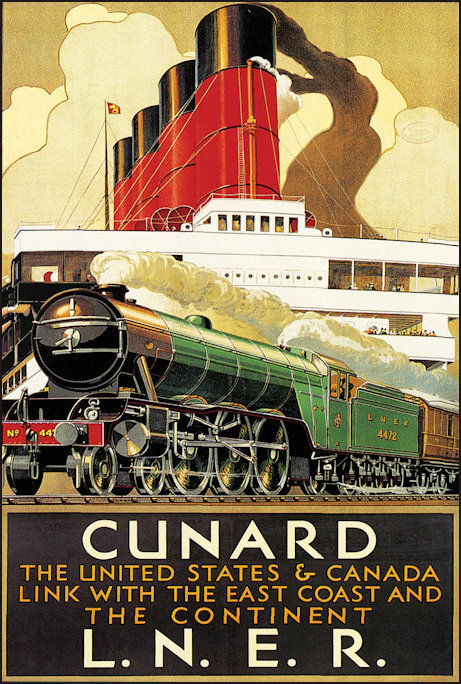
Unusual combination of Sea and Rail Travel on one visual image
Travel Poster produced for the London & North Eastern Railway (LNER) to promote connecting rail and sea services between North America, England and the Continent on the Cunard White Star. The poster shows an illustration of a steam locomotive with an ocean liner in the background. Artwork by an unknown artist. Sourced from travelpostersonline
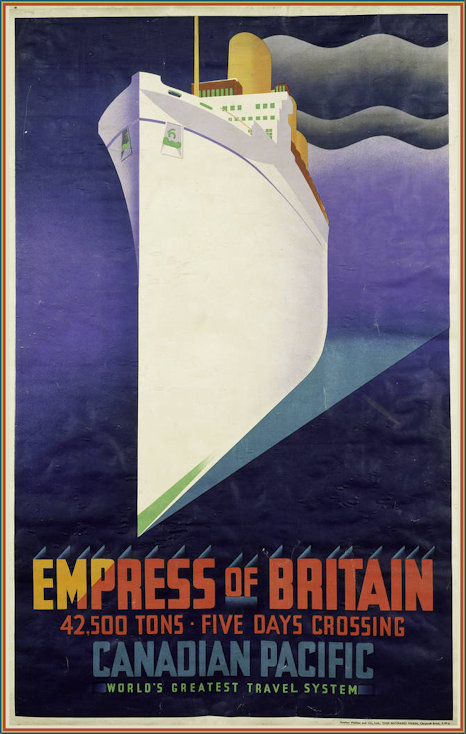
The 'Empress of Britain' poster forms part of the V & A Ocean Liners Exhibition
So many areas of every day life are covered by a water theme in the 1930s, whether the Sea, Open Air Lidos, Cruises, Fashion or architecture and decorative art visit the various pages on this website for a holistic view - the Midland and Ocean Hotels, the Lido Section (don't forget to see how some, but not all were saved from dereliction or put to alternative uses), the Marine Building in Vancouver all can be found on the Home Page devoted to this section.
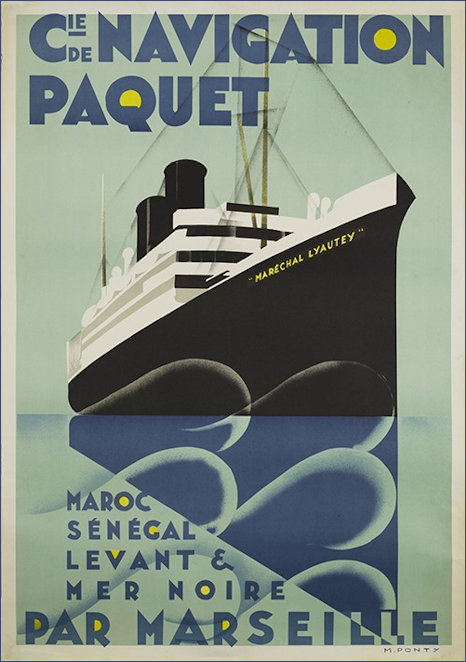
I love the fact that Max Ponty (1904-1972) signs his posters, here he is enticing us to visit Morocco, Senegal, the Levant and Black Sea - image courtesy of affichesmarci.com
Even the USSR jumped on the poster bandwagon!
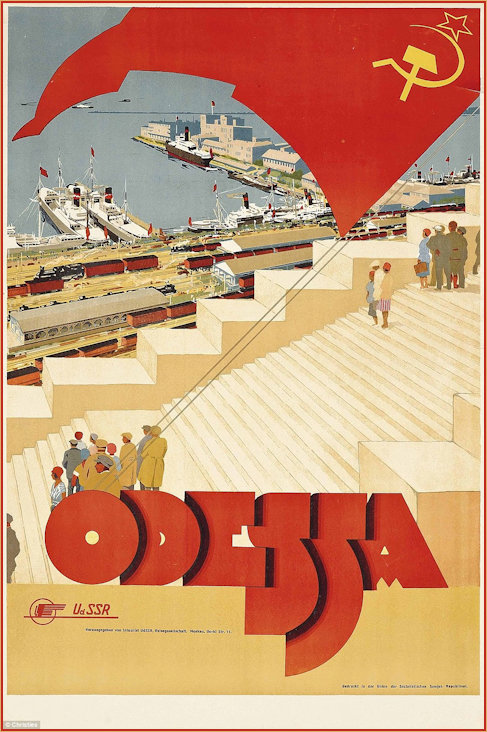
Image courtesy of Christies Auctioneers via the Daily Mail
From the Daily Mail : These 1930s travel posters are advertisements with a difference - they are designed to encourage tourism to the USSR. The vintage posters were designed to advertise flights and train routes to the Soviet Union through the travel company Intourist - founded by Joseph Stalin in 1929. The posters - commissioned in the 1930s - were designed to encourage visitors to the Communist country, before the Second World War and ensuing Cold War closed off the Soviet Union to westerners.
27th May, 1936 - RMS Queen Mary
As the RMS Queen Mary celebrates her 80th anniversary it seems right to give her pole position on this page - for a spectacularly in-depth report visit the Daily Mail article here
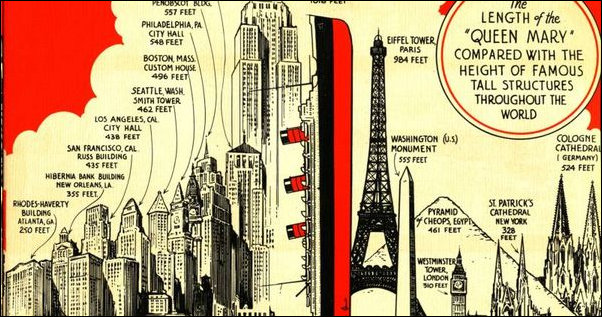
Promotional material courtesy of classicliners.net
The RMS Queen Mary, a luxurious ocean liner that carried the world’s rich and famous before the dawn of the jet age, is celebrating the 80th anniversary of its maiden voyage. One of the greatest passenger ships ever built, the 1,020ft Queen Mary left Southampton on 27 May 1936 en route to New York, the first of many transatlantic crossings that attracted the likes of Winston Churchill, John F Kennedy, TS Eliot, Elizabeth Taylor, Bob Hope and many other glamorous guests.
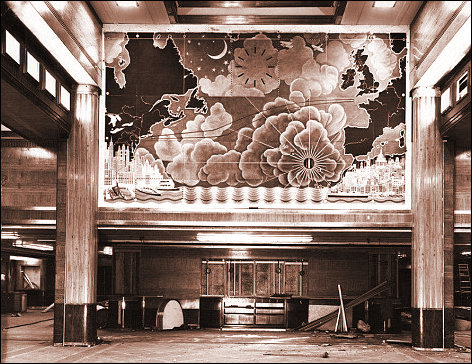
The first class dining room was multiple storeys with large columns and an innovative celestial-style mural by MacDonald Gill brother of the Midland Hotel's Eric!
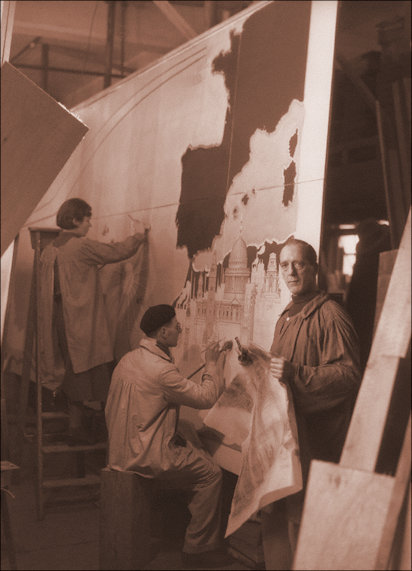
Macdonald Gill with two assistants working on 'Decorative Map of the Atlantic' for RMS Queen Mary by Howard Coster half-plate film negative, 1936 - Image and narrative courtesy and © of the National Portrait Gallery

A fascinating decorative map, 24ft. by 15ft. occupies a similar position at the forward boundary of the apartment. The work of Mr. MacDonald Gill, F.R.I.B.A., this map represents the North Atlantic Ocean, and the artist has treated the subject in a bold formalistic style, with the composite groups of typical buildings of England and America at the sides, a large illuminated chart being the main feature. Further interest is added by the introduction of a clock and the vessel’s summer and winter courses; while an illuminated model in crystal indicates the position of the ship on the voyage between Bishop’s Rock and the Nantucket lightships.
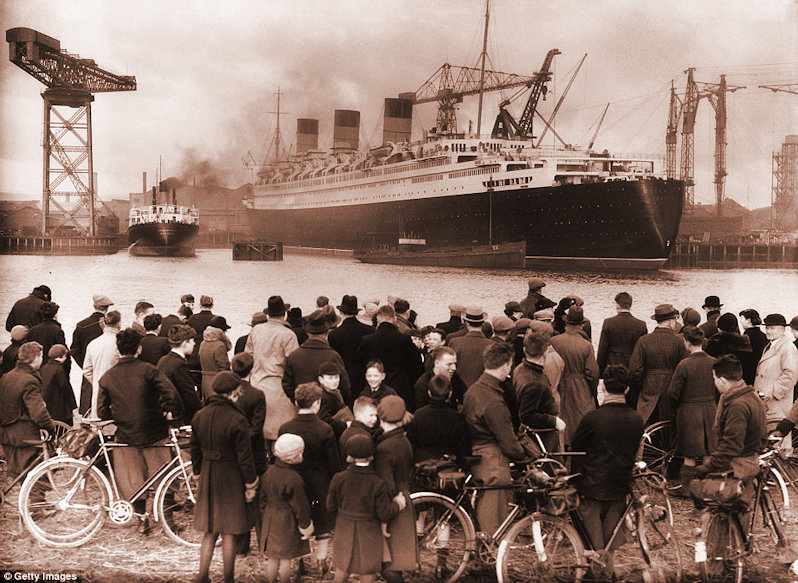
A crowd admires the Cunard-White Star Line passenger ship the RMS Queen Mary at Clydebank, near Glasgow, in Scotland in 1936

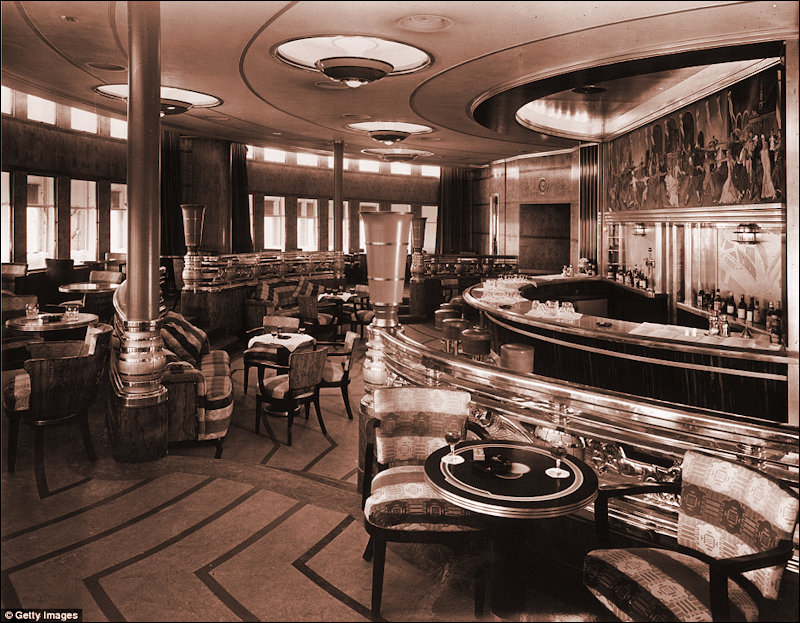
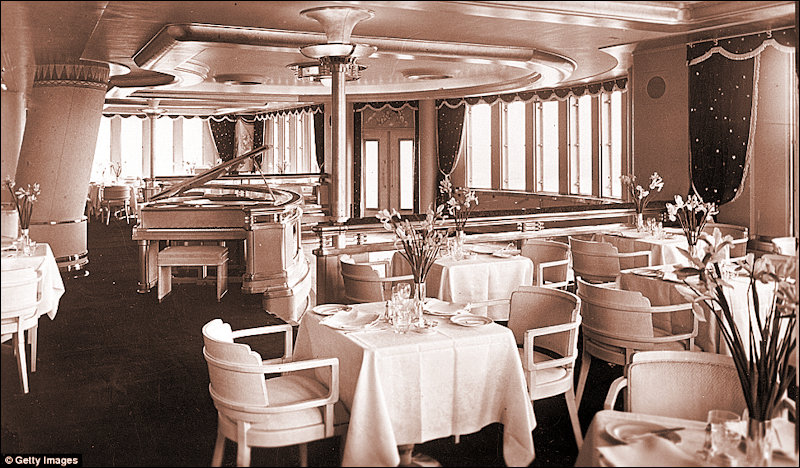
Cabin class passengers had a number of elegant dining options, including the veranda grill where they were entertained by a pianist
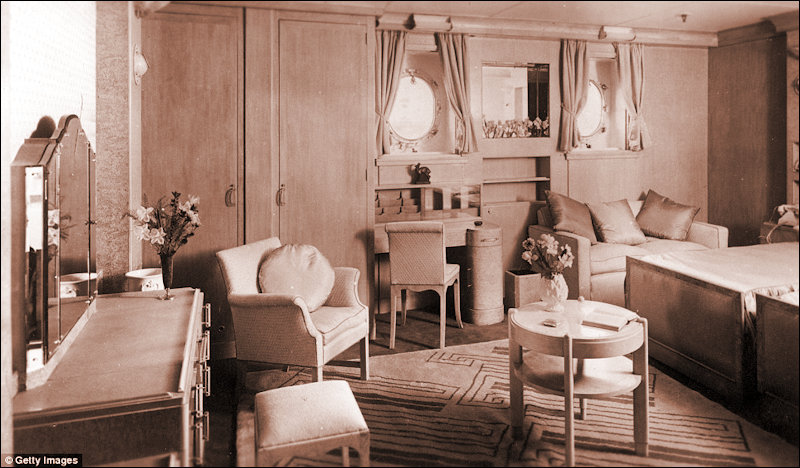
The interior of a luxurious cabin class bedroom, reserved for the wealthiest travellers, as pictured on a postcard from the 1930s
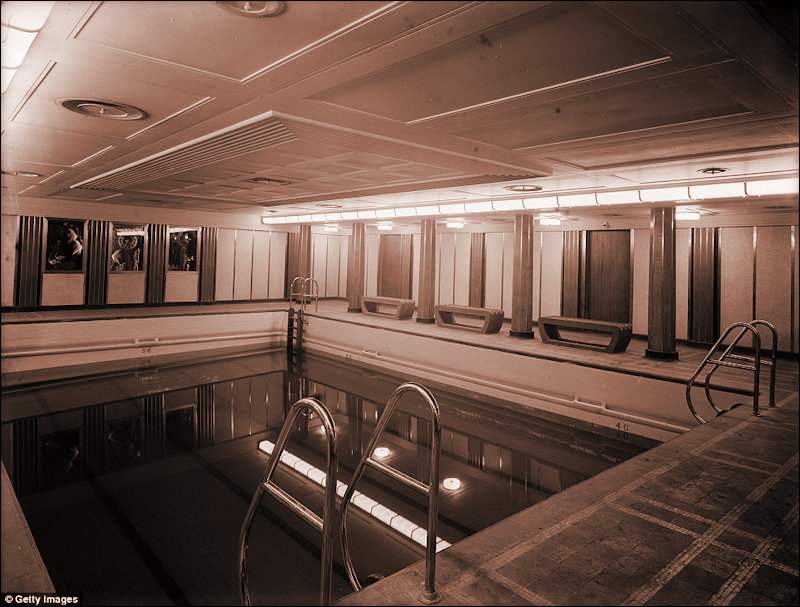
5th March 1936: A view of the swimming pool on board the transatlantic passenger liner SS Queen Mary, which is nearing completion at the shipyard on Clydebank, Scotland. Measuring 1,020 feet in length, with a gross tonnage of 81,237, the Queen Mary won the Blue Riband for the fastest crossing of the North Atlantic in 1938. She was withdrawn from service in 1967, and is currently moored at Long Beach, California. (Photo by Fox Photos/Getty Images)
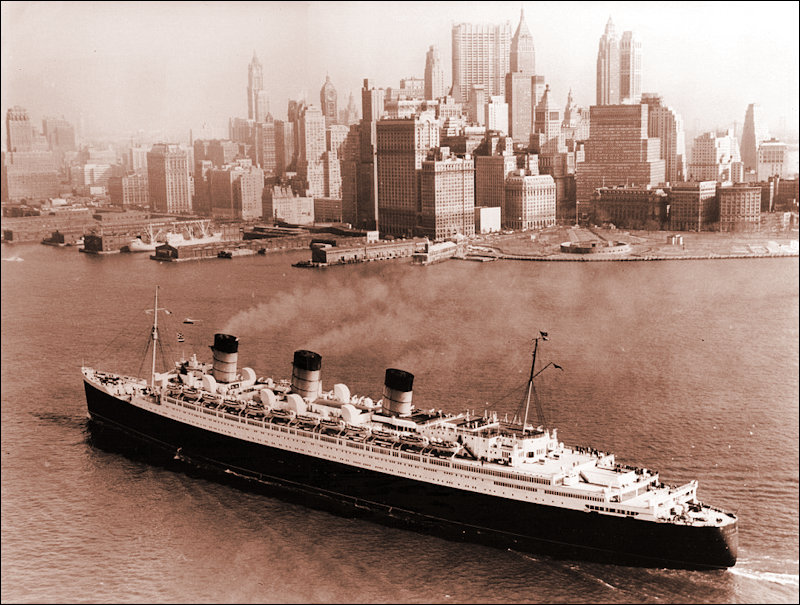
The Queen Mary sailed between New York and Southampton until it was taken out of service in 1967 due to financial losses
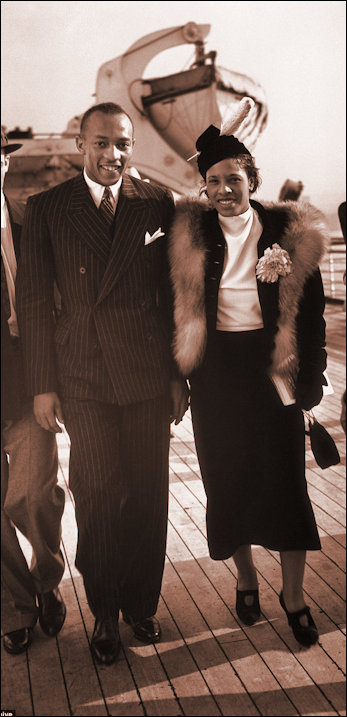
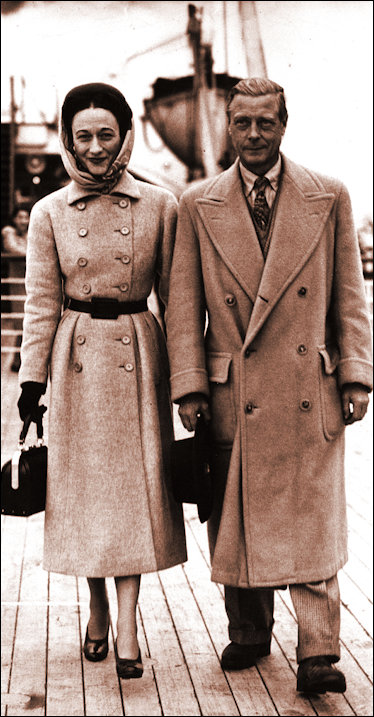
Frequent 'Flyers' l to r - Olympic track champion Jesse Owens, who won four golds at the Berlin Games in 1936, and his wife, Ruth, are welcomed in New York / The Duke and Duchess of Windsor were among the members of the royal family who either toured or sailed on board the Queen Mary
All images of and relating to the Queen Mary in this section (except where otherwise stated) are courtesy and © of Getty Images and the Bellman Archive (under renovation by USITT)
The Art Deco liner was the largest and fastest passenger ship in the world when it launched, and had three classes of cabins, an opulent first class dining room, ballroom, cocktail bars, a stage for music, two indoor swimming pools, a squash court, libraries, a telephone connection and a small hospital. It was the flagship of Liverpool-based Cunard-White Star Line when it left John Brown & Company’s shipyard in Clydebank, Scotland after six years of construction.
The historic Queen Mary transported Allied soldiers during World War Two and returned to passenger service until it was retired in 1967 as profits dropped and the jet age took off. Today, the historic ship is permanently moored in Long Beach, California, where it has been preserved as a tourist attraction with a museum, hotel, restaurants and an exhibition containing some of Princess Diana's belongings.
The Queen Mary offered a 'souvenir' launch book which detailed artists work and provided comprehensive pictures of the ship and its accommodation - for an interesting tour visit here.
29th May, 1935 - SS Normandie
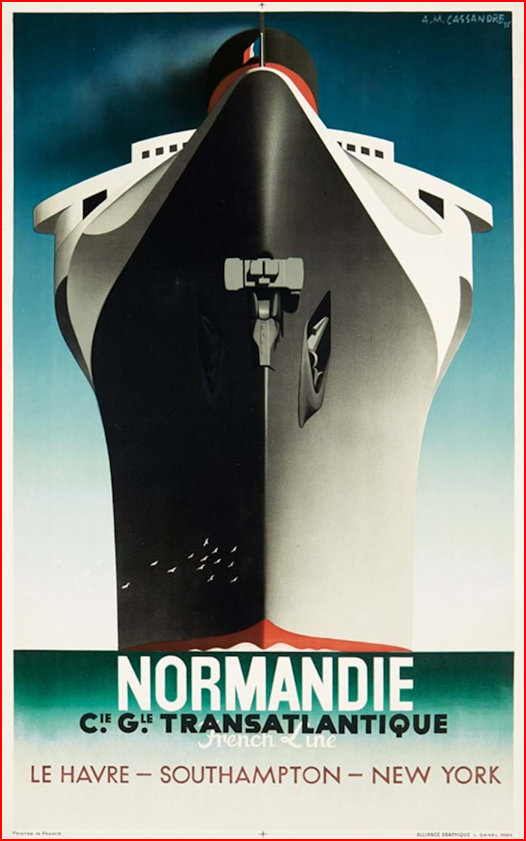
The instantly recognisable poster of the SS Normandie - image sourced from and courtesy of antiquestradegazette.com
Opulent Art Deco luxury liner SS Normandie relics sail into auction
Tom Derbyshire - 31st May 2017
Once a flagship of the glamorous age of luxury liners, redolent of the Art Deco style and dripping with opulence, the SS Normandie ended her days broken up for scrap after being ravaged by fire. This floating palace had been the largest ocean liner in the world, the pride of French design, with the latest technology including one of the earliest radar sets used on such a vessel. She took the Blue Riband prize on her maiden voyage for the fastest Atlantic crossing. Normandie entered service in 1935, but just six years later was trapped by the war in New York and taken over by the US Coast Guard and renamed USS Lafayette. In 1942, during a refitting to make her suitable as a troop transport, she caught fire and eventually capsized under the weight of the water used to fight the blaze. The Art Deco profile of the once mighty ship was encapsulated in a famous poster by Adolphe Mouron, the artist known as Cassandre, showing a huge bow towering above the viewer and the simple but powerful word Normandie beneath. A flock of gulls emphasises the sheer scale of the vessel.
The ship was moored in New York's harbour when it caught fire in February 1942, and it was also in the Big Apple that one of those posters came up for auction at Swann Galleries on May 25. It sold to a collector for $18,500/£11,620 (or $22,500/£14,530 including premium) against an estimate of $12,000-18,000. Several versions of the design – a frequent but high-selling visitor to salerooms – exist, with the lettering below Normandie varying.
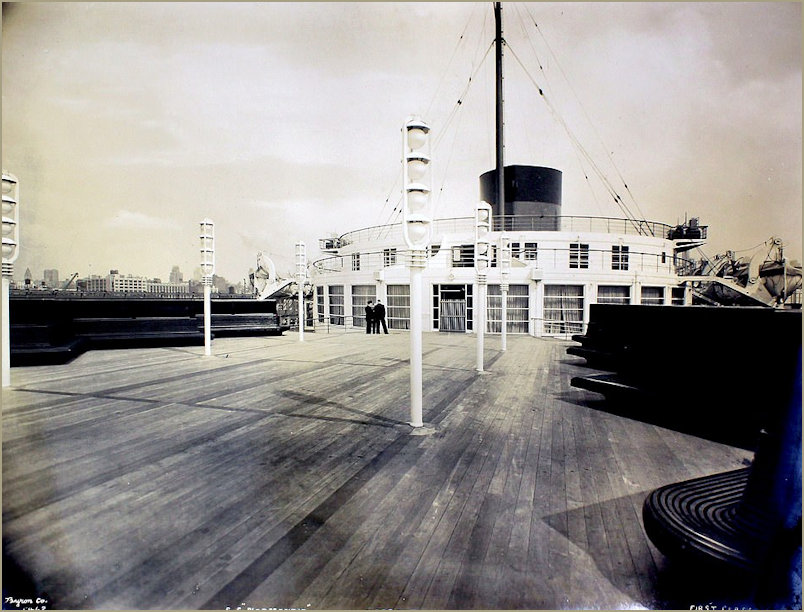
The First Class terrace which featured classy light fittings so that guests could come out and enjoy a sea breeze at any time of the day or night. After the ship was commandeered by the US in World War Two it suffered tragedy with work almost complete for its military refurbishment a spark from a welder's torch ignited a bale of lifejackets and the liner was destroyed in the blaze. What was left of her was towed to Brooklyn Navy Yard and eventually scrapped.
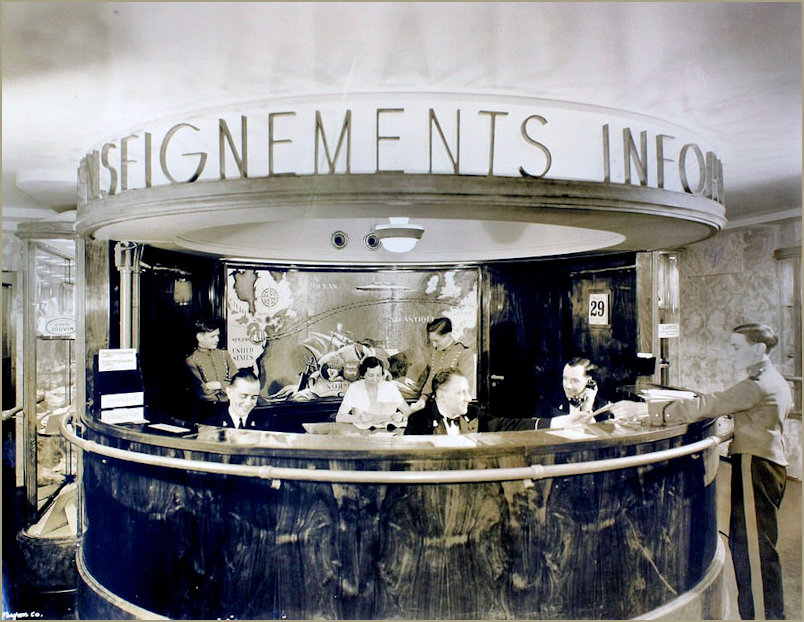
The 'Information Bureau' on board the ship. Auctioneer Tony Pratt said of the unique album of images: 'They document many of the now iconic works on this floating Art Deco 'cathedral' and give a fascinating glimpse of the beauty, glamour, luxury, comfort and sheer scale of the magnificent liner and what it must have been like to travel in such opulence.'

Guests of the SS Normandie chat before dinner in the foyer of deck B dressed to the nines, the men wearing dinner jackets, while the women wear the flapper dresses of the era. As they prepare to enter, a waiter can be seen cracking open the colossal 20ft doors to the dining area to check on dinner preparations
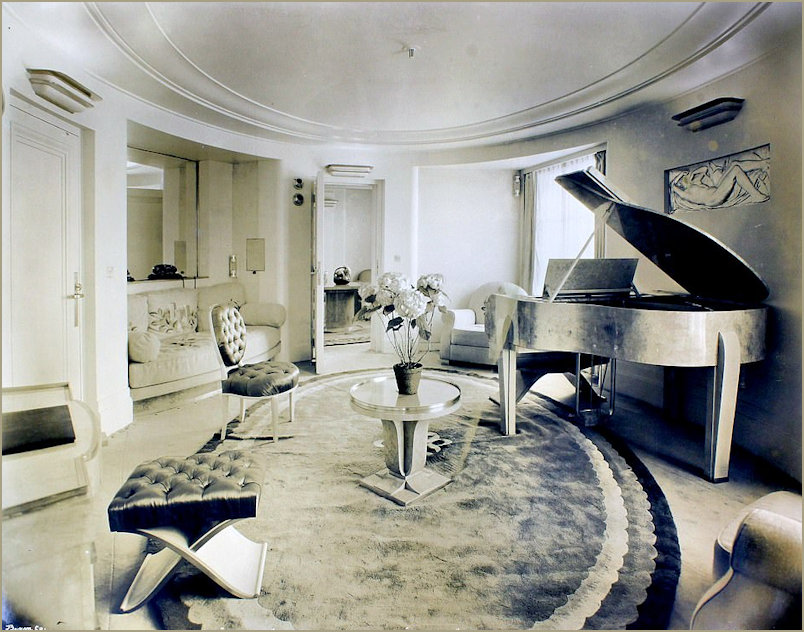
One of the luxury First Class apartments, featuring plush carpets and furniture in decadent crushed velvet with a baby grand piano to cater for the whims of the musical guests. The majority of the passengers were First Class and this gave the SS Normandie a reputation as being exclusively for the rich and famous
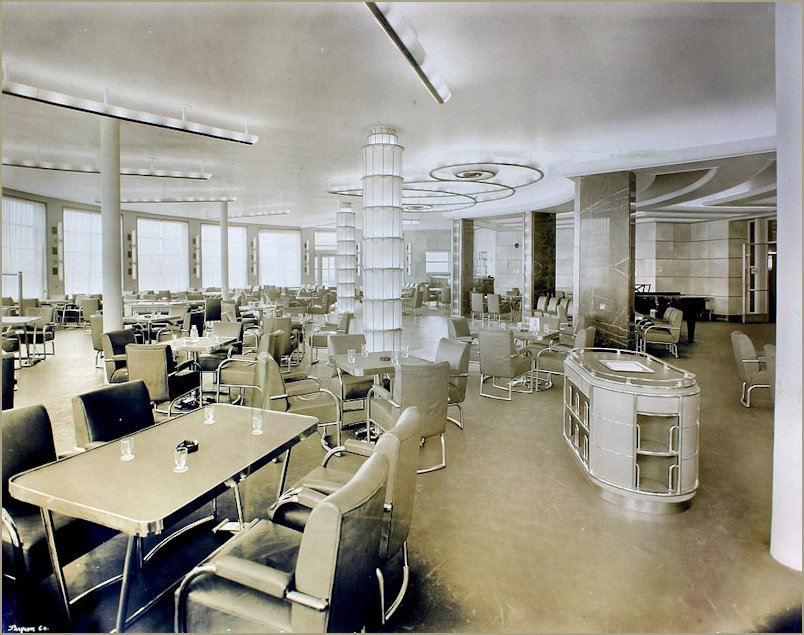
The cafe grill was a space for more casual dining and refreshments during the day, but would be cleared in the evening for dancing and served as the ship's nightclub, where the Jazz music of the 1930s could be heard late into the night. A large grand piano tinkled during the day time, but at night a razzle dazzle line up would perform for the guests
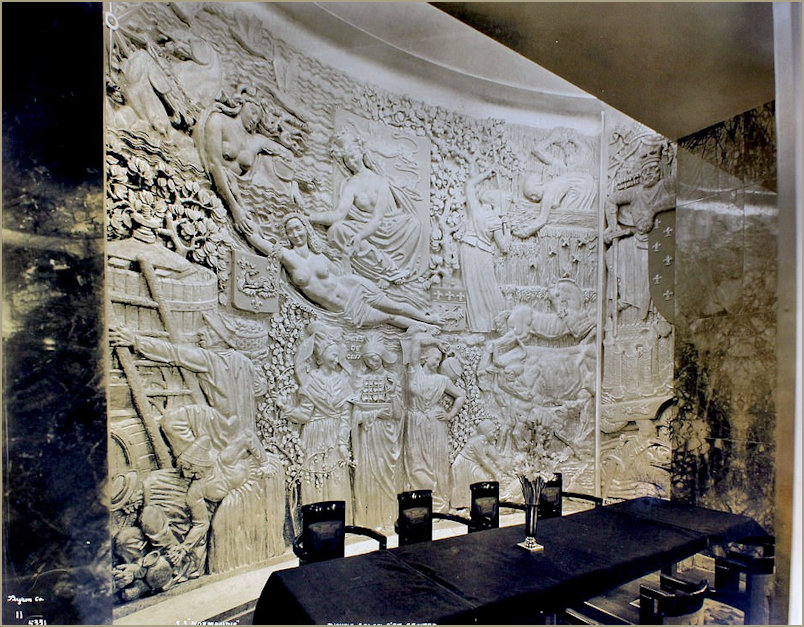
A table in the Dining Salon is surrounded by opulent marble wall panels and a sculpted mural in the wall representing the Norman history of the ship's namesake. The coat of arms of the Norman kings can be seen featuring the fleur-de-lis, while peasants can be seen picking grapes from the vines and pressing them in large barrels
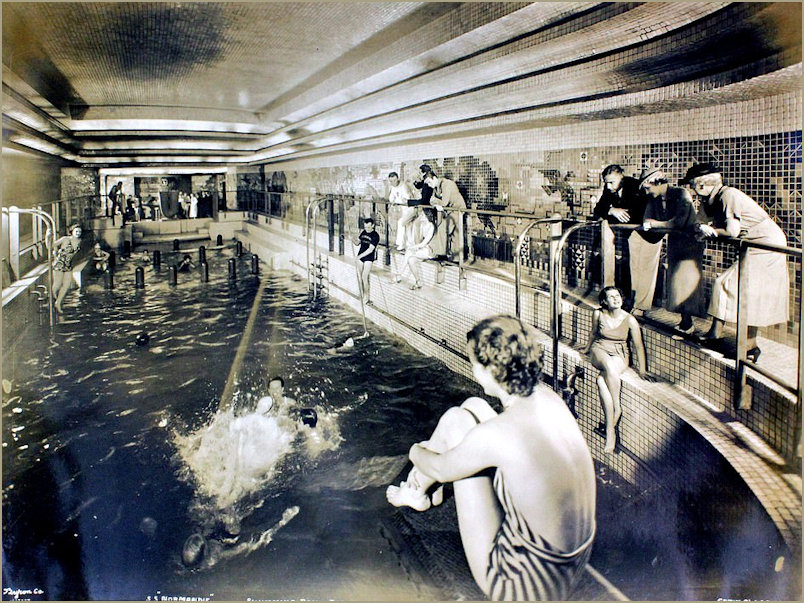
Children can be seen splashing in the First Class swimming pool while other bathers sit on the staggered ledges at the sides of the pool. There was a bar at one end and a shallow beach area for children at the other. As well as being functional, the pool area is decorated with tiles and its walls are contoured with the luxurious styles of the Art Deco period.
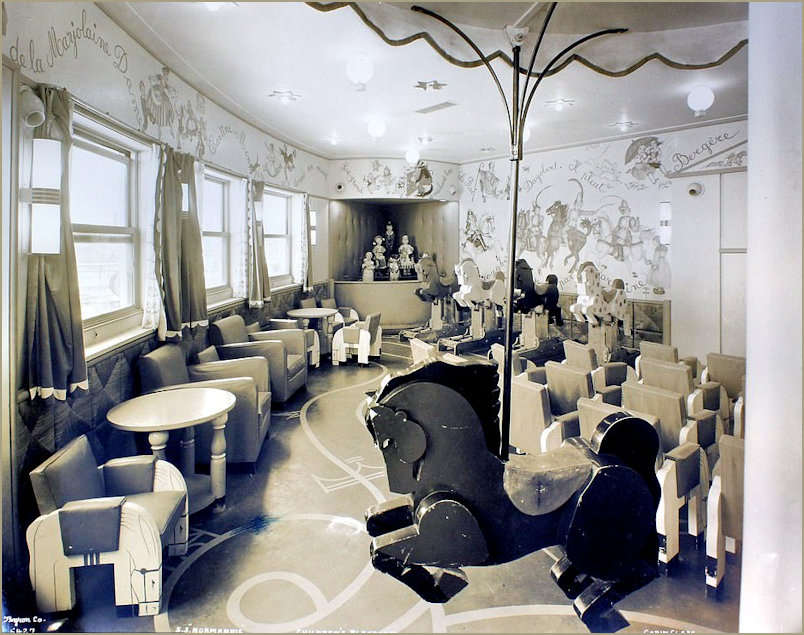
The children's playroom on The Normandie. The children had a dining room decorated by Jean de Brunhoff - the author of the Babar books - whose beloved Babar the Elephant and his friends appeared across the walls.
The above 8 images and descriptions were all sourced with grateful thanks from the Daily Mail article dated 2nd April 2019
- The colossal 1,000ft 'floating palace' was the height of luxury and the fastest across the Atlantic in the world
- The SS Normandie made her maiden voyage from Le Havre in France to New York in just over four days
- The majority of her passengers travelled in First Class and enjoyed the luxuries of the grandest hotels
- She had a swimming pool, dance floors, numerous bars and a dining room which had doors rising 20ft high
By Ross Ibbetson For Mailonline | Published: 2nd April 2019 | Updated: 2nd April 2019
The 1,000ft French passenger ship was the largest and fastest liner in the world when she made her maiden voyage from Le Havre to New York in 1935. The SS Normandie made 139 crossings before she was confiscated by the Americans at the advent of World War Two. After Pearl Harbour was attacked by the Japanese, she was renamed USS Lafayette and was to be converted into a troop ship.
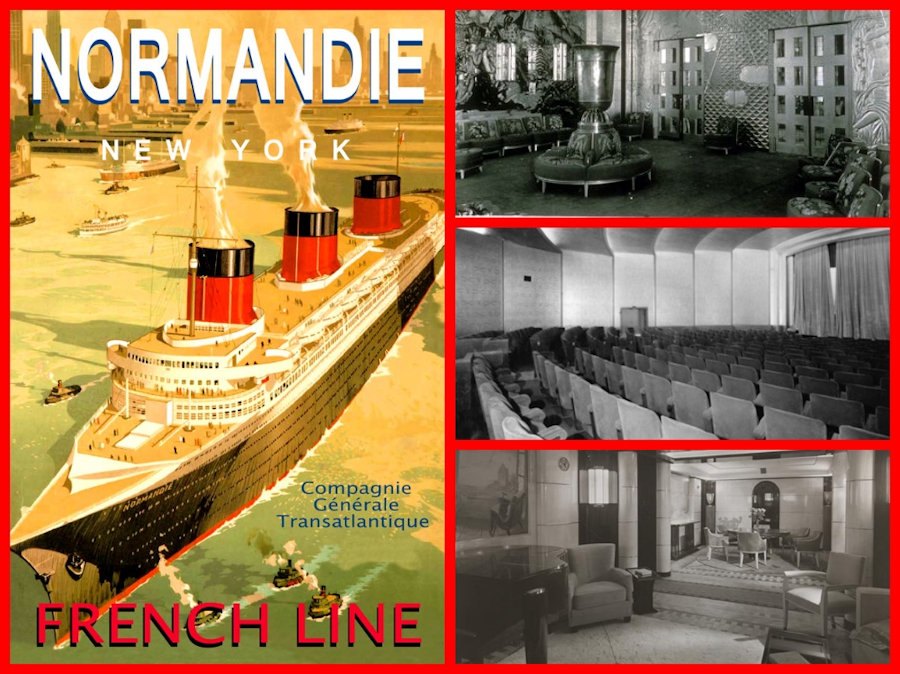
image sourced from Cruisinglinehistory.com
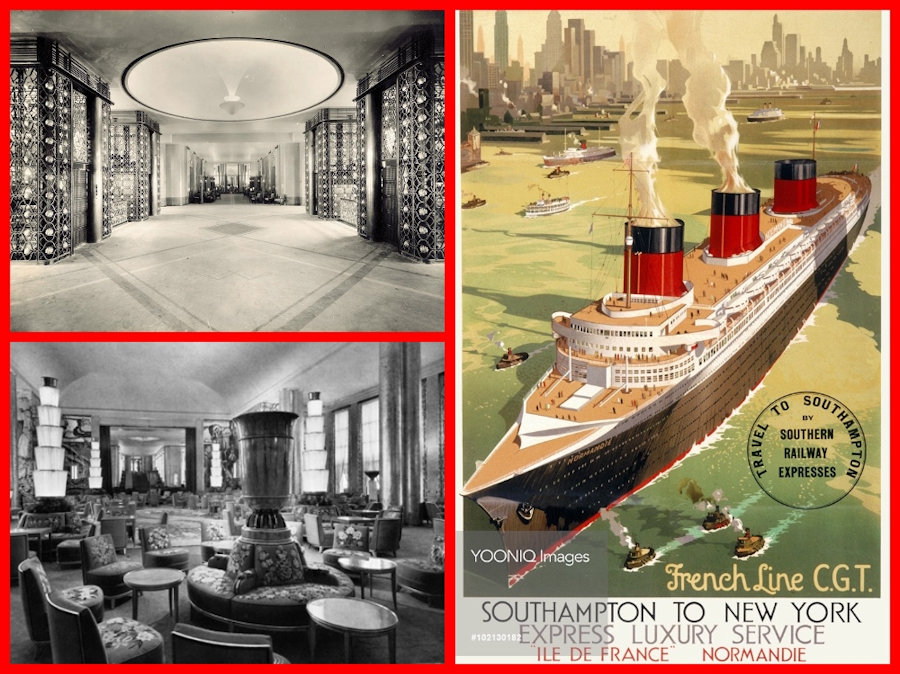
- image sourced from Cruisinglinehistory.com with thanks
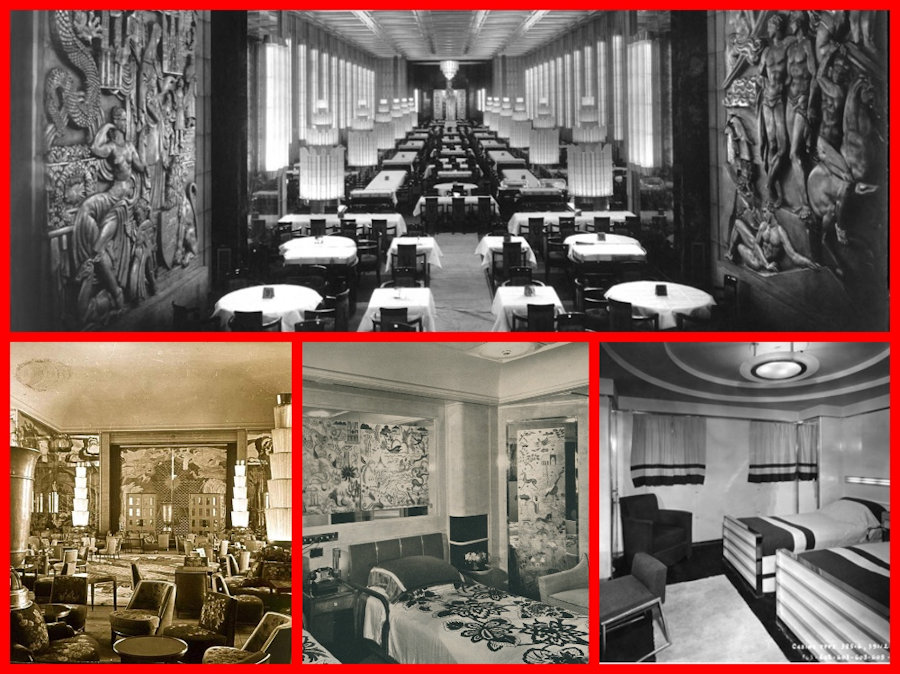
- image sourced from Cruiselinehistory.com with thanks
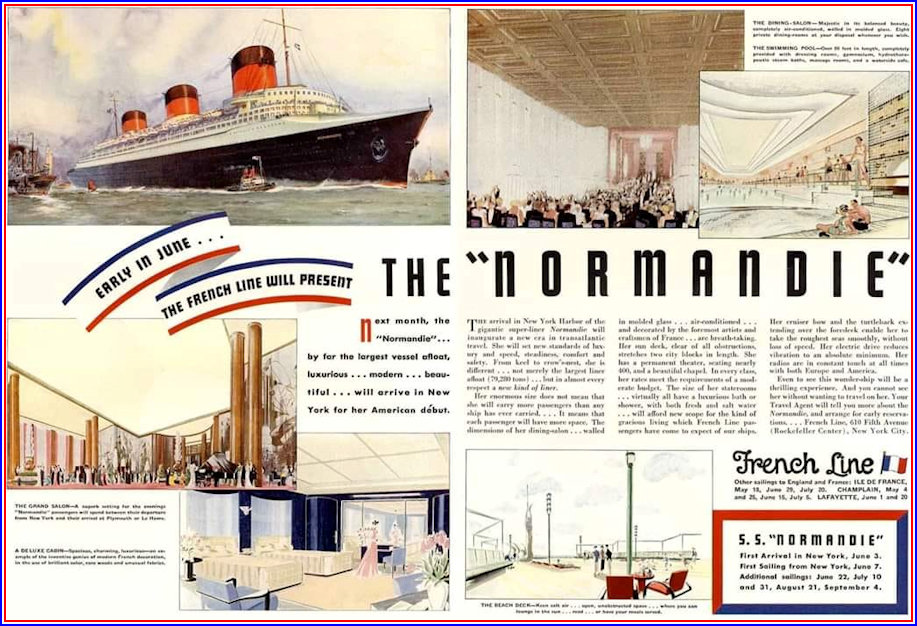
Read more : New York Almanack | Daily Mail |
The MV Irpinia
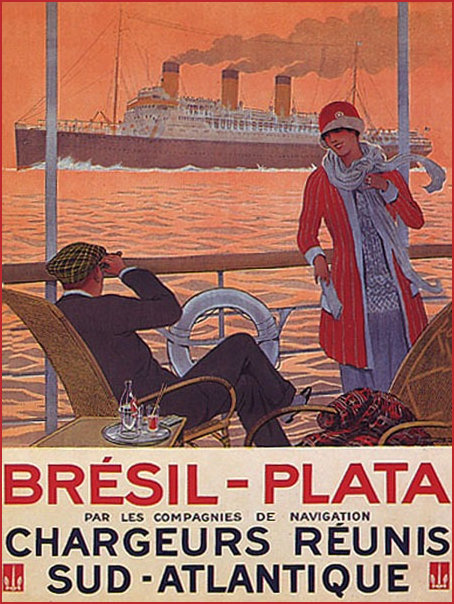
As little information is available on this ship with a remarkably chequered history, some artistic licence is needed - comparable image sourced from mercadolivre.com.br
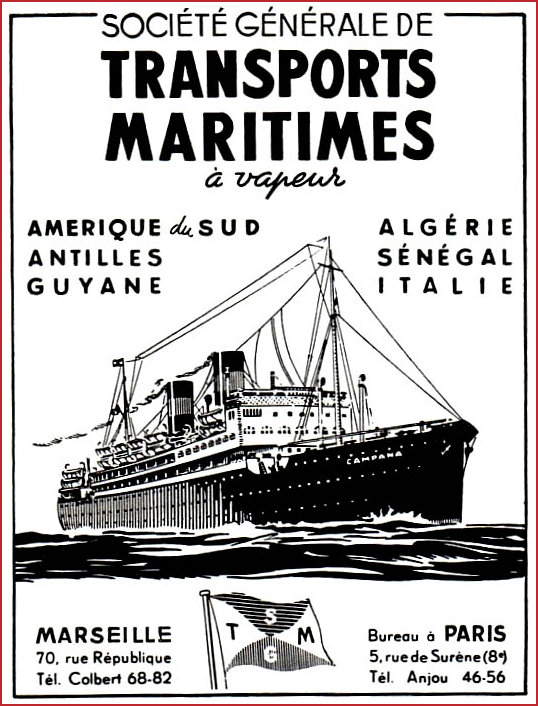
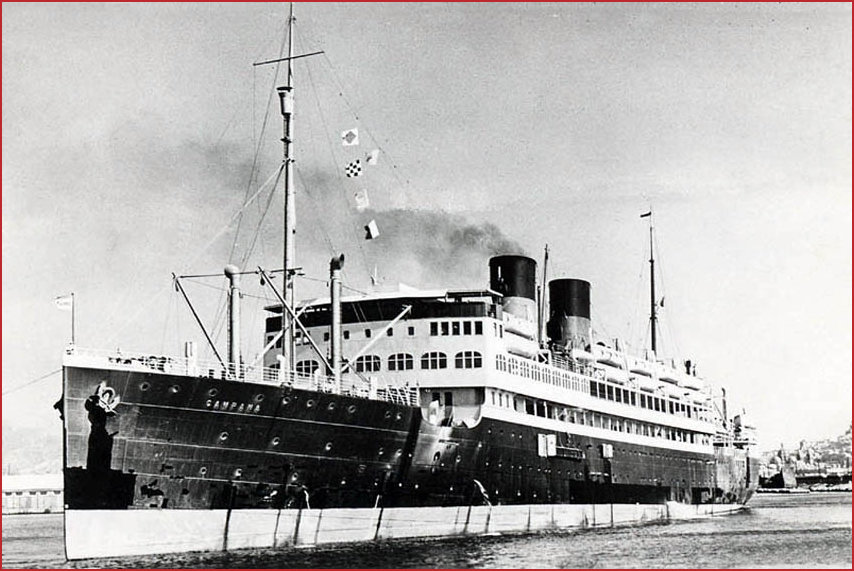
The original design of the Irpinia as she was previously and originally known as the Campana and a commercial advertisement - images source from SSMaritime.com
The Irpinia was built as the SGTM liner Campana in 1929 by Swan, Hunter on the River Tyne. She sailed from Marseilles to the East Coast of South America, Rio de Janeiro, Santos, Montevideo and Buenos Aires. After the fall of France in 1940, Campana was laid up at the latter port, and later seized by the Argentineans, for whom she ran some trips to New Orleans as the Rio Jachal. In 1946, she was returned to the French, sailing to South America again, but also to Indochina. She was bought by Grimaldi-SIOSA in 1955. She operated from Europe to the Caribbean and Venezuela, with some crossings of the North Atlantic to Canada or New York. In 1962 she received a major facelift, returning to service with only one funnel and Fiat diesels instead of steam turbines. She returned to the Caribbean route, taking Spanish and Portuguese migrants westbound, and west Indian migrants eastbound to the UK. By 1970 she was mainly used for Mediterranean cruising out of Genoa, at $79 for seven days, or $134 for a 2-week Christmas cruise to New York and the Canaries. In 1976, just as she was about to be withdrawn, she was chartered for the making of the film Voyage of the Damned. After the filming, she unexpectedly returned to cruising until 1981, at which point she could no longer get a certificate of seaworthiness in Italy. She was laid up for 2 years in La Spezia before being scrapped.
The story of SS Campana and the T/v Irpinia is one that is worth sharing, as she was just one of the last well-built and fine Blue Liners that sailed the Seas of the world for over a half a century! Part 1 here | Part 2 here
The RV Kalakala
The RV Kalakala described as the world's first 'streamlined' vessel and certainly does evoke the 'streamline moderne' so beloved by the 1930s and applied mostly to the architecture resembling the sleek liners of the day. But the uniqueness of the Kalakala and its historic and native background has to have a page of its own which can be found here and a fitting tribute website here

80th anniversary celebrations
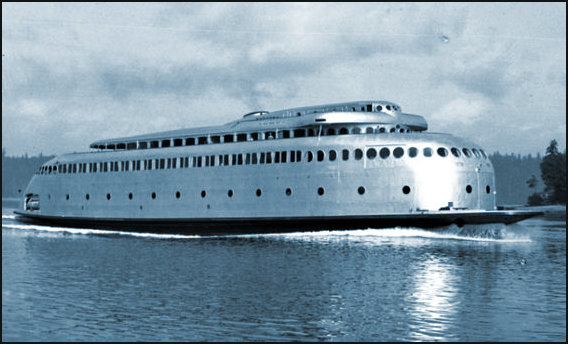
The RV Kalakala at the height of its popularity - Images courtesy and © of Kalakala.org
Page updated : 7th May 2020 (G)